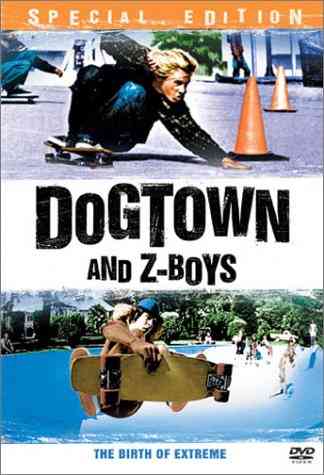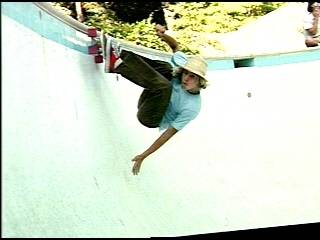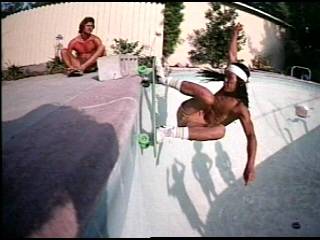
|
|
|
|
|
|
|
|
|
|
|
|
|
(2002) Director: Stacy
Peralta
"Two hundred years of American technology has unwittingly created a massive cement playground of unlimited potential. But it was the minds of 11 year-olds that could see that potential" - Craig Stecyk It's a certainty that when it comes to extreme sports,
almost all of us could be considered armchair athletes. And from that,
it's pretty safe to assume that during at least one point of our lives,
we have wondered in our minds, while watching these extreme athletes on
TV or in real life engaging in their passion, the burning question,
"How on earth did they get the guts to participate in these sports
themselves?" After a little thought on that question, I think I have
come up with an explanation that at least partially answers that query:
They saw other people before them engage in these sports successfully,
and then they told themselves, "If they can do it
successfully, well, so These questions, at least the ones for skateboarding, are answered in Dogtown & Z-Boys, an insightful look into the origin of the style of skateboarding that today is now commonplace and with names like Tony Hawk becoming as known as names like Tiger Woods. There are some people I know who will be instantly turned off by this documentary because it involves skateboarding. They are people who associate the sport with those punk kids in the supermarket parking lot who seem to have nothing better to do than jump into the air while they are not moving, rotating their skateboard under their feet in the air during the process. Too bad for them. No, I am not saying this as a former skateboarder - in fact, I've never cared for the sport while I was growing up, and I've never even really ridden one in my entire life. Yet all the same, I can appreciate the sport, because I do see it as a kind of art. You can't deny it takes a lot of skill and practice to be in such control while traveling at such a high speed, often in a confined space. You also sense a great feeling of enthusiasm from these skateboarders while they're at it, and seeing them go through their paces without a care in the world and with no real feeling of competition from anyone else, you start to understand why skateboarding is so popular even if you would never do it yourself. Much like how proper examination of Shakespeare's plays comes from analyzing how the stories originally were before the Bard rewrote them in his style, Dogtown & Z-Boys wisely starts a few years before extreme skateboarding started. Unsurprisingly, we learn its origins came from the surfing culture of the early '70s, still considered then an outlaw sport even with documentaries like The Endless Summer. More specifically, it was surfing in the western part of Los Angeles in an area nicknamed Dogtown, a derelict district made up of several beach communities where the beach bums really could be considered bums. However, due to dedicated surfing non-conformists like Jeff Ho and his buddies, who started their own outlaw surf shop that catered to and nurtured other similarly-minded surfers, the Dogtown residents not only built up a sense of self-esteem, but a "Screw you" attitude aimed towards outsiders that let them know they were determined to do just whatever they wanted for the hell of it. Nicknaming themselves the Zephyrs, the surfers antics (such as their suicidal surfing in the nearby run-down Pacific Ocean Park) couldn't help but make an impact on the local Zephyr-wannabe youth, especially since most of them were from broken homes and their only adult male influence coming from Ho and his pals. At the same time, the Zephyr youths did a lot of things
themselves that combined were a big part of what made them become such
big skateboard stars. Needless to say, it was only a matter of time before the newly-gained abilities of the Zephyrs broke out of the open secret atmosphere it had been growing and dwelling in, and finally broke out into the mainstream during the historic Del Mar Nationals in 1975. The documentary takes us to every step leading up to that point and what subsequently happened to the sport and the Zephyrs afterwards. We learn how the request of a boy dying of brain cancer made to his father indirectly lead to the discovery of aerial maneuvers, due to that and the stubbornness of skateboard legend Tony Alva. During the coverage of the fateful tournament, we learn just how unprepared other skateboarding teams - still skating in the same old-fashioned way of the '60s - were completely unprepared for both the Zephyrs' skills and uncouth "Screw you" attitude. Needless to say, it brought an interesting range of reactions from both spectators and other skateboarders, and it's one of the highlights of the documentary. All the same, it had a big impact on American youth culture, and the documentary charts the explosive growth of skateboarding - which, ironically, lead to the perhaps inevitable break-up of the Zephyr gang once big business saw how lucrative skateboarding could be. Strangely, though the documentary freely shows how influential the Zephyrs were on today's skateboarders, it totally skips out telling of how the skateboarding fad suffered another huge collapse around 1980 and needed several years to resurrect itself. It would have been really interesting to detail this, covering why it seemed to die overnight and how the Zephyr gang reacted to this. While we don't learn the Zephyrs' reaction to skateboard's momentary death, we do get to learn a substantial amount about them, not just through the plentiful amount of resurrected footage of them rolling around, but through interviews with the members now in their middle age. It isn't surprising to hear how fondly they look back on those days - after all, most of them today are still involved in surfing or skateboarding as a hobby or a business. One thing interesting to find out is that one of these pioneers was female (Peggy Oki); regretfully, we don't learn how she entered and was accepted in such a male-oriented macho sport, stories that undoubtedly would have been interesting to hear. However, a number of interesting things about other Zephyr members are revealed, especially when we learn about their reactions to their sudden fame and being in demand. Strangely, the results of their decisions are opposite
of what you might expect. Stacy Peralta (who was in Skateboard Madness) decided to make as
much money as he could at the time, and eventually became a successful
skateboard filmmaker (including this documentary!) Tony Alva was
heavily aggressive to everyone on and off the skateboard ramp, but he
used his determination to found his own skateboard company at 19. It's
clear even today he hasn't lost any of his spunk, when we see that he
still skateboards to this day. Compare their stories to Jay Adams,
Most of all, you can't help but admire the "push and praise" attitude they developed - to try and be the best, but at the same time showing no favorites to anyone who might be "king for a day," as one skateboarder puts it. You might think skateboarding would be the last place to find such a welcome feeling of nostalgia, so Dogtown & Z-Boys director Peralta deserves praise for managing to do so. Though he unfortunately falls into the MTV-inspired epileptic filming style of nowadays (rapid and confusing editing, shuffling around of still images, quick zooms and speed-ups, etc.) which is very distracting, he does achieve the main goals of the documentary - we have a good idea what it was all about, how it all became about, and who was all about during all this. As I said, I know that people still won't care about this documentary, because it all involves skateboarding. But I don't think it really matters what sport this documentary covers, because the core of the movie really tells us something important - and it's that many big things that have happened came from not being 100% planned, but simply from circumstances, personal perseverance, and a little bit of plain old luck. Check
for availability on Amazon (VHS) See also: Biker Dreams, On Any Sunday, Skateboard Madness |
 can I."
Fine. But then after a little more thought on this subject of extreme
sports, another question pops up. How on earth then did the sport
originate? Who had the idea to originate the world's first demolition
derby? Which motorcyclist was the first to consider taking the
motorbike off the road and into the air with jumps over school buses?
For that matter, which individuals changed the sport of skateboarding -
which previously for several decades been confined to coasting down
small slopes and weaving in and out of lines of traffic cones - so that
seemingly overnight it went far beyond such simple feats into
incredible stunts such as getting up to the speed of a racing car or
acrobatics in mid-air? And while we're at it, what on earth got into
these skateboarders' minds to create all of this?
can I."
Fine. But then after a little more thought on this subject of extreme
sports, another question pops up. How on earth then did the sport
originate? Who had the idea to originate the world's first demolition
derby? Which motorcyclist was the first to consider taking the
motorbike off the road and into the air with jumps over school buses?
For that matter, which individuals changed the sport of skateboarding -
which previously for several decades been confined to coasting down
small slopes and weaving in and out of lines of traffic cones - so that
seemingly overnight it went far beyond such simple feats into
incredible stunts such as getting up to the speed of a racing car or
acrobatics in mid-air? And while we're at it, what on earth got into
these skateboarders' minds to create all of this? Strangely, they never
intended to become so dedicated to skateboarding in the first place.
Originally dedicated surfers, they only went to skateboarding because
the only time conditions were right to surf were in the morning, and
they needed something to do for the rest of the day that was
even remotely like it. Skateboarding had in fact originated in the late
'50, but in the early '70s it was so dead that the Zephyr youths had to
make their own homemade skateboards. Then they scrounged around Los
Angeles for any place with concrete "waves", from long downhill streets
to asphalt banks around schools, gradually incorporating some surfing
moves into their skateboard routines. But it was also circumstances
that pushed skateboarding up to the next level. California suddenly
suffered the worst drought on record, and the strict water restrictions
meant pool everywhere were empty and waiting... or could be quickly
emptied of the little remaining water though the skaters' ingenuity. At
first the curved pool banks were unknown territory to everyone, but
through patience and experimentation, new stunts and skills quickly
evolved out of this new environment.
Strangely, they never
intended to become so dedicated to skateboarding in the first place.
Originally dedicated surfers, they only went to skateboarding because
the only time conditions were right to surf were in the morning, and
they needed something to do for the rest of the day that was
even remotely like it. Skateboarding had in fact originated in the late
'50, but in the early '70s it was so dead that the Zephyr youths had to
make their own homemade skateboards. Then they scrounged around Los
Angeles for any place with concrete "waves", from long downhill streets
to asphalt banks around schools, gradually incorporating some surfing
moves into their skateboard routines. But it was also circumstances
that pushed skateboarding up to the next level. California suddenly
suffered the worst drought on record, and the strict water restrictions
meant pool everywhere were empty and waiting... or could be quickly
emptied of the little remaining water though the skaters' ingenuity. At
first the curved pool banks were unknown territory to everyone, but
through patience and experimentation, new stunts and skills quickly
evolved out of this new environment.  who
became disillusioned by the commercialization of the sport and quit.
Though he expresses no real regrets about certain mistakes he made, the
other skateboarders hint these things had more of an impact than he
lets on - as we finally find out seconds before the closing credits
come up. Fortunately, all the other former Zephyr members have much
happier things to tell us. The surprising thing is that despite all the
fame and fortune they made, they are very humble about it all, telling
us things like, "We were at the right place at the right time" and "We
didn't think there was any future in it. We were doing it because we
loved doing it. When they tell us of a particular fond memory, they do
it with such passion and fondness that you can't help but get caught up
in their enthusiasm, even if they use a slang or technical term that
you might not understand. You admire them for their ingenuity, whether
it was figuring out how to drain the last bit of water from an
appealing swimming pool, or figuring out how just to get higher or
fancier that anyone else before them.
who
became disillusioned by the commercialization of the sport and quit.
Though he expresses no real regrets about certain mistakes he made, the
other skateboarders hint these things had more of an impact than he
lets on - as we finally find out seconds before the closing credits
come up. Fortunately, all the other former Zephyr members have much
happier things to tell us. The surprising thing is that despite all the
fame and fortune they made, they are very humble about it all, telling
us things like, "We were at the right place at the right time" and "We
didn't think there was any future in it. We were doing it because we
loved doing it. When they tell us of a particular fond memory, they do
it with such passion and fondness that you can't help but get caught up
in their enthusiasm, even if they use a slang or technical term that
you might not understand. You admire them for their ingenuity, whether
it was figuring out how to drain the last bit of water from an
appealing swimming pool, or figuring out how just to get higher or
fancier that anyone else before them.